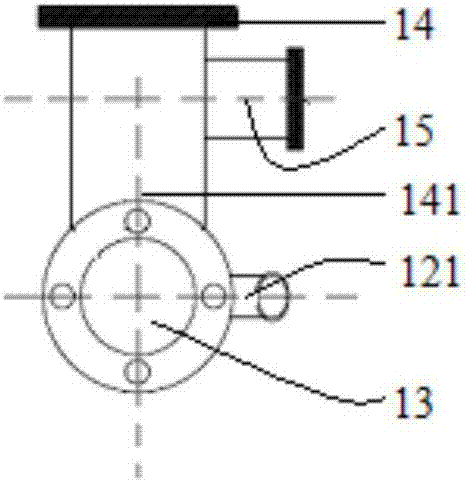Infrared in-situ reaction test device based on pumping detection, and use method thereof
An in-situ reaction and testing device technology, used in measurement devices, material analysis by optical means, instruments, etc., can solve the problems that it cannot be used to study the reaction between different gases and samples, and cannot be filled with different gases, and achieves expanded applications. range, effective resistance to corrosion, and ease of precision manufacturing
- Summary
- Abstract
- Description
- Claims
- Application Information
AI Technical Summary
Problems solved by technology
Method used
Image
Examples
Embodiment 1
[0065] An infrared in-situ reaction test device based on pump detection, including an in-situ reaction cell, a gas buffer mixing cell, a base and a sample device, wherein, such as Picture 1-1 , Figure 1-2 and Figure 1-3 As shown, the in-situ reaction cell includes a horizontal cylindrical reaction cell casing 11, and detection windows 13 are detachably arranged at both ends of the reaction cell casing 11; The housing branch 121, the axis of the reaction pool housing 11 and the axis of the housing branch 121 form an included angle of 45°. The end of the casing branch 121 is detachably provided with the pump window 12; the reaction cell casing 11 is provided with a vertical cylindrical sample branch 141, and the sample branch 141 is hollow and its axis passes through the bottom of the reaction cell casing 11. The intersection of the axis and the axis of the housing branch 121; the end of the sample branch 141 is provided with a sample port joint 14, and the side of the sampl...
Embodiment 2
[0088] Take the study of the charge carrier dynamics of ZnO semiconductor as an example. After dispersing the ZnO powder in ethanol, add it dropwise on the calcium fluoride crystal of Φ13mm and 1mm in thickness, dry it under an infrared lamp, fix it in the sample holder 42, and adjust the nut of the sample holder 42 to ensure that the height of the sample is at At the intersection plane of the probe light and the pump light, rotate the top cover 41 angles at the same time, so that the surface of the sample is perpendicular to the pump light. Connect the CF bayonet or flange and other connecting parts, turn on the power of the mechanical pump and vacuum gauge, and vacuum overnight to remove the physical adsorption components on the surface of the sample. After the nitrogen gas is pumped into a vacuum, the pump light uses the triple frequency light (355nm) of the semiconductor laser (the fundamental frequency is 1064nm) to excite the sample, and the detection wavelength is 2000-...
PUM
| Property | Measurement | Unit |
|---|---|---|
| Thickness | aaaaa | aaaaa |
| Thickness | aaaaa | aaaaa |
Abstract
Description
Claims
Application Information
 Login to View More
Login to View More - R&D
- Intellectual Property
- Life Sciences
- Materials
- Tech Scout
- Unparalleled Data Quality
- Higher Quality Content
- 60% Fewer Hallucinations
Browse by: Latest US Patents, China's latest patents, Technical Efficacy Thesaurus, Application Domain, Technology Topic, Popular Technical Reports.
© 2025 PatSnap. All rights reserved.Legal|Privacy policy|Modern Slavery Act Transparency Statement|Sitemap|About US| Contact US: help@patsnap.com



